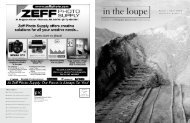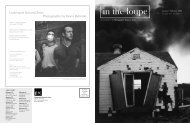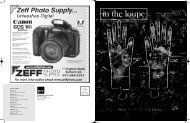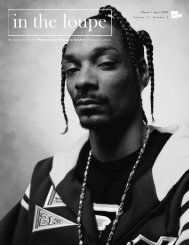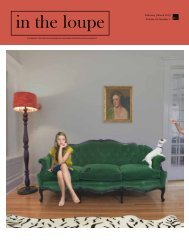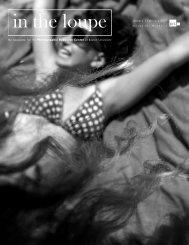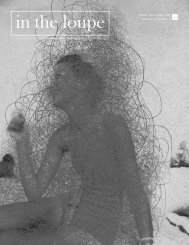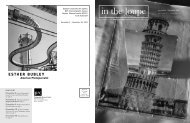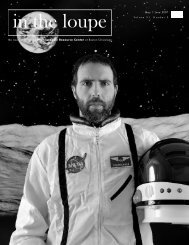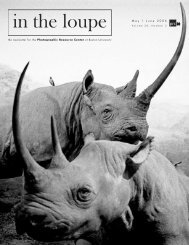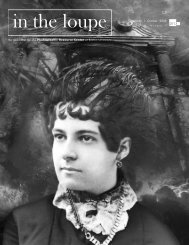January | February 2002 - Boston Photography Focus
January | February 2002 - Boston Photography Focus
January | February 2002 - Boston Photography Focus
Create successful ePaper yourself
Turn your PDF publications into a flip-book with our unique Google optimized e-Paper software.
an improvisation on<br />
mus i c and photograp<br />
Leslie K. Brown, Curator, PRC<br />
From his loft on Third Avenue, John immersed himself in the ferment of<br />
the New York City art scene. Soon after he arrived, John had his first exhibition<br />
at Helen Gee’s Limelight. In 1959, his neighbor Robert Frank asked<br />
an shared. experience<br />
Of Dylan, Cohen recalls a moment in 1962, when he “showed me the words<br />
The eye permits us to experience and to document the thing depicted, but is rarely sufficient to convey the deeper meaning of<br />
John to take production stills of the filming of Pull My Daisy. The images<br />
produced during those sessions are among the finest portraits ever of Allen<br />
Ginsberg, Jack Kerouac, and Frank himself. In return, Frank photographed<br />
the New Lost City Ramblers for a series of images that would grace the<br />
covers and liner notes of their albums for years to come. John’s loft became<br />
a crossroads for musicians and artists. An organization of independent photographers,<br />
with members including Lee Friedlander, Gary Winogrand, and<br />
others, was formed there. Southern musicians on their way to and from<br />
performances dropped by, as did Woody Guthrie, Alan Lomax, and others<br />
involved in the folk-music revival.<br />
Throughout the late ’50s and early ’60s, Cohen toured extensively with the<br />
New Lost City Ramblers, sharing the stage with rural musicians like Roscoe<br />
Holcomb and the Stanley Brothers as well as with emerging stars such as<br />
Bob Dylan and Joan Baez. Robert Cantwell, whose When We Were Good<br />
(1996) outstandingly documents the growth and decline of the folk music<br />
revival, noted that during this period the Ramblers “raised the nap of the<br />
revival with newly esotericized discographic sources and a performance style<br />
that sounded as exotic as a Tibetan prayer.”<br />
Also during the late 1950s Cohen took the first of many trips to Peru,<br />
ostensibly to study Andean textile production. In the isolated mountain<br />
region of Q’eros he photographed Indian weavers at work, learning their<br />
vocabulary and rituals and developing a deep appreciation for Andean<br />
music. Years later, Cohen returned to Q’eros to make the films Mountain<br />
Music of Peru (1984) and Carnival in Q’eros (1992). He also recorded and<br />
released two albums of traditional Peruvian music. One of his recordings,<br />
of a young girl singing an Andean huano, was included as a sample of the<br />
sounds of our planet that was sent into space on the Voyager spacecraft.<br />
In 1962, the young Bob Dylan visited for a portrait session on John’s Third<br />
Avenue rooftop. In addition to their common appreciation for traditional<br />
music, the two men shared a close friendship with the ailing Woody Guthrie.<br />
to his new song A Hard Rain’s Gonna Fall. At first it resembled the old ballad<br />
Lord Randall or Where Have You Been Billy Boy. Then it seemed like an<br />
old French symbolist poem to me, and I invited Bob to look at some of<br />
that poetry at my loft. I thought his verses were very strong although I<br />
couldn’t imagine how he would fit them to music. The night of the Cuban<br />
Missile Crisis when it felt like the world was on the brink of atomic collision,<br />
Dylan and I sang together at the Gaslight Café. We did an old Carter<br />
Family song, You’re Gonna Miss Me When I’m Gone, not certain if there’d be<br />
anyone left to miss us.”<br />
By the late ’60s the Ramblers were performing in large halls like the Fillmore,<br />
in lineups with supergroups such as The Grateful Dead, the Jefferson<br />
Airplane, and the Jimi Hendrix Experience. Cohen notes that during this<br />
time “a shift of sensibilities set in. The beat generation had prepared the<br />
stage for the counter culture, while the emerging civil rights movement<br />
shook the social landscape… For me, a decade of wide-eyed wandering<br />
with my camera was closing down… So much of what I’d responded to on<br />
a poetic level was becoming entertainment and commerce… Further, there<br />
was my own dissatisfaction with the prospects of ever getting my work seen<br />
on its intended level. By the time the photography galleries were opening<br />
I was somewhere else.” That “somewhere else” was filmmaking.<br />
John shot his first film, a silent two-reeler, on the rooftop with Dylan.<br />
Beginning with his landmark 1962 feature, The High Lonesome Sound,<br />
John has made a total of fifteen documentary films, including important<br />
work on the folk culture of Peru and on the North Carolina musician<br />
Dillard Chandler (The End of an Old Song, 1970). “I made films about<br />
music,” he writes. “And that challenge became so great and transformative<br />
that it became my main effort for the next twenty years.”<br />
Behind the scenes, but central to the picture, is the growth of John’s own family.<br />
In the early 1960s, Cohen married Penny Seeger. The youngest child of<br />
musicologist Charles Seeger and composer Ruth Crawford Seeger, after the<br />
death of her mother when Penny was eight she lived with her half-brother<br />
Pete. A potter by training, she also sang with her siblings Mike and Peggy on<br />
several collections of American folk music, including the classics American<br />
Folk Songs for Christmas and Animal Folk Songs for Children, both of which<br />
drew extensively from their mother’s folk music collection. To support his<br />
family, John took a position as Professor of Visual Arts at the State University<br />
of New York, Purchase, where he worked until his retirement in 1997.<br />
Penny and John raised two children, Rufus and Sonja, in Putnam Country,<br />
New York. In the summer of 1965, when daughter Sonja was still an infant,<br />
her parents brought her to the Newport Folk Festival where the Ramblers<br />
were scheduled to perform. Uncle Pete Seeger opened the program by playing<br />
a cassette of Sonja crying, announcing to the audience, “Here’s the real<br />
folk music.” Sonja, now an adult, has recorded two highly regarded recordings<br />
with composer Dick Connette’s Last Forever project, which draws its<br />
inspiration from American traditional music. Her brother Rufus, also a<br />
musician, works in New Mexico as a textile craftsman. The Cohen family<br />
is featured in both the exhibition, where photographs document their<br />
growth, and in John’s CD, There Is No Eye: Music for Photographs. The CD<br />
presents a musical counterpoint to the exhibition, with songs by many of<br />
the artists whom John photographed, from Rev. Gary Davis and Holcomb<br />
to Dylan and David Amram, and includes pieces by Rufus and Sonja.<br />
In all of John Cohen’s work, his collecting, photographing, filmmaking,<br />
performing, teaching, and parenting, a layer of pure fact (i.e., the thing<br />
depicted) is combined with a layer of meaning conveyed (i.e., the memory<br />
revived or the tradition shared). The eye permits us to experience and to<br />
document the thing depicted, but is rarely sufficient to convey the deeper<br />
meaning of an experience shared. Individual songs or photographs may<br />
describe specific moments in time, and each moment possess a distinct historical<br />
narrative, which we may know by looking.<br />
But experience is not conveyed by looking, or wisdom by simply reading.<br />
This has been a central theme of the New Lost City Ramblers, and it is<br />
implicit in John Cohen’s photographs as well. Meaning and value are conveyed<br />
not through the eye alone, but through the active and generous<br />
bequest of tradition and knowledge from one generation to another, from<br />
one culture to another, from teacher to student, and from parent to child.<br />
This, for me, is the underlying message of John Cohen’s work, and the<br />
deeper narrative of this exhibition: there is no eye because, in the end, it is<br />
the exchange of songs, the sharing of wisdom, the flow of knowledge, and<br />
the gift of life that are important, and not the individual eye/I.<br />
John P. Jacob, Guest Curator<br />
Penobscot, Maine 2001<br />
John Cohen’s photograph, Jack Kerouac Listening to<br />
Himself on the Radio, (seen at left) demonstrates, literally and humorously, the<br />
complex conundrum photographers face when attempting to document subjects<br />
of an auditory nature. Can photography adequately capture a musical<br />
moment by recording the performer, or even a snippet of the performance?<br />
In this short improvisation, an etude if you will, I attempt to cast a wider net<br />
and muse upon Cohen’s fascinating photographs within a larger historical<br />
and philosophical context.<br />
From its inception, photography has been lauded as a method for nature to<br />
reproduce itself. While this was meant primarily in the visual sense — cameras<br />
were often compared to eyes — artists have long attempted to capture the<br />
non-perceptual. Those seeking the abstract saw in sound an equivalent for<br />
the internal non-objective world for which they were searching: an aesthetic<br />
“music of the spheres”. While photography and dance seemed to partner more<br />
readily, painting took especially to music: James Abbott McNeill Whistler<br />
and Wassily Kandinsky titled their canvases symphonies and compositions,<br />
while Piet Mondrian explored the pulsating rhythms of jazz.<br />
This is not to say that photographers did not engage music or its attendant<br />
ideas. In fact, some saw photography as particularly suited for the task.<br />
Cohen alludes to this ability when explaining why he did not become a<br />
painter: “The lens became the center of an equation with the visible world on<br />
one side and the interior world on the other.” Many culture mavens at the<br />
turn of the last century were interested in synaesthesia, or the crossing of various<br />
senses whereby one could see music and hear colors. Such beliefs led to<br />
the invention of fascinating instruments such as the color organ, which<br />
played colors instead of music. Photographer Francis Brugiuère made some<br />
of the earliest abstract photographs and films documenting patterns produced<br />
by such an apparatus. Playing off the Theory of Correspondences so<br />
popular with the Symbolists, Alfred Stieglitz photographed clouds, initially<br />
titling them “Music,” intending that they stand in for mental states akin to<br />
those induced by melodies.<br />
Cohen’s exhibition, book, and accompanying CD provide the viewer (and<br />
listener) with a rare opportunity to see (and to hear) what he has recorded.<br />
Although freezing performers in mid refrain or strum, his photographs are not<br />
silent; instead they sing with beautiful formal relationships. When Cohen’s<br />
photographs don’t show music, they imply it, transforming the viewer into a<br />
makeshift deejay. Images of Cohen’s wife in Peru and a lone figure in a Tenth<br />
Street studio, for example, almost give rise to a melancholy dirge.<br />
One would think that photography’s use of a negative and its ability to be<br />
repeated and reinterpreted much like a musical score would make these arts<br />
close cousins. Ansel Adams’s much-repeated comparison of the negative to<br />
sheet music and its printing to performance alludes to this attribute. Quite<br />
the opposite, many photographers even go so far as to destroy their negatives<br />
so no one can translate them. Ironically or aptly, Cohen’s re-discovery of<br />
Left to right: 1. John Cohen, Woody Guthrie at Cooper Union. Courtesy of the artist and<br />
Deborah Bell, New York. 2. John Cohen, Third Avenue, New York City, 1962. Courtesy of the<br />
artist and Deborah Bell, New York. 3. John Cohen, Philadelphia, 1961. Courtesy of the artist<br />
and Deborah Bell, New York. 4. John Cohen, Jack Kerouac listening to himself on the radio.<br />
Courtesy of the artist and Deborah Bell, New York. 5. John Cohen, Harlem, New York City,<br />
1954. Courtesy of the artist and Deborah Bell, New York. 6. John Cohen, Harlem, New York<br />
City, 1954. Courtesy of the artist and Deborah Bell, New York.<br />
(continued on page 8)<br />
6 7




